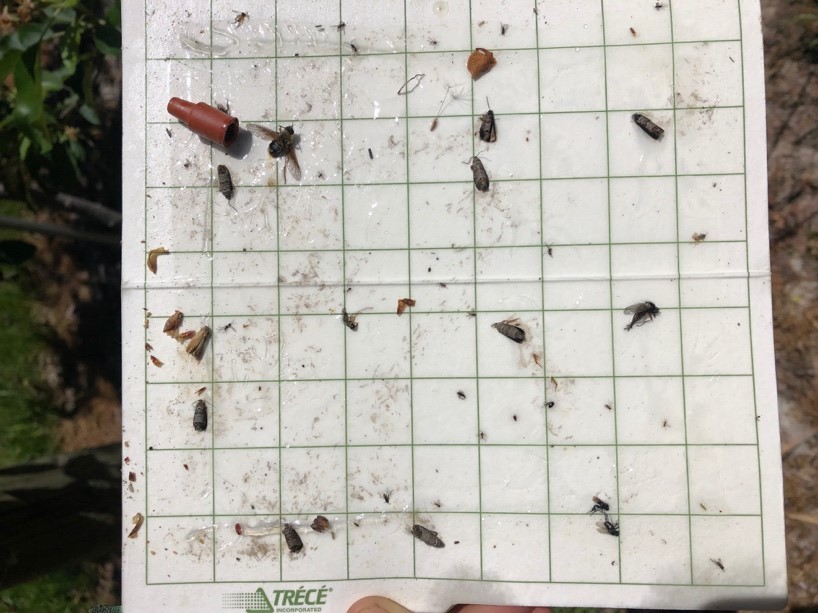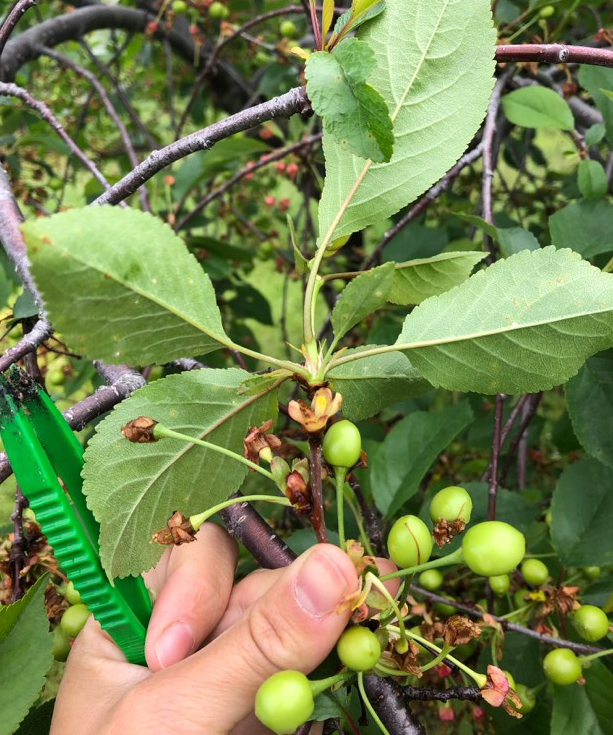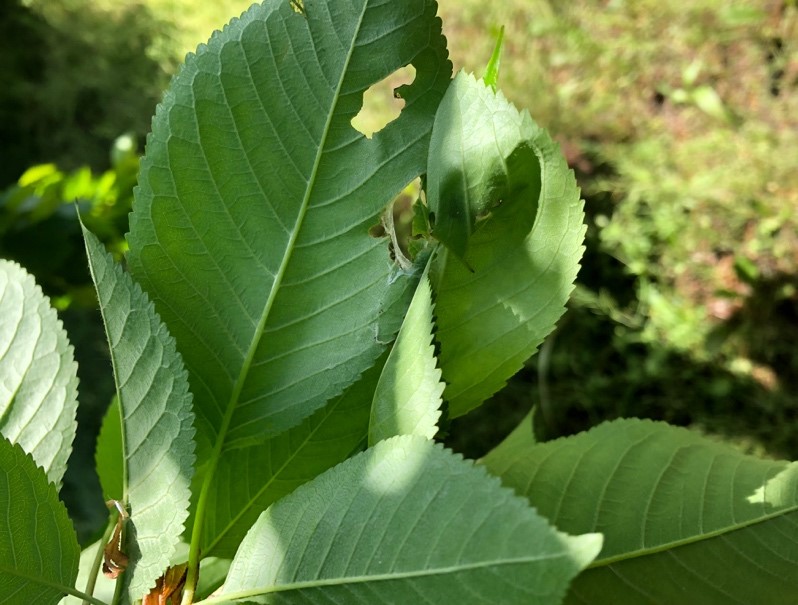Northwest Michigan fruit update – June 11, 2019
Growers are taking advantage of the break in the rain to get covered for another round of wet weather.

Weather report
Weather continues to be wet and cool. We did sneak a few warm, sunny days in over the weekend and picked up a few growing degree days (GDD) in these conditions. Thus far, we have accumulated 615 GDD base 42 and 295 GDD base 50. However, we are still behind our 30-plus year averages: 836 GDD base 42 and 448 GDD base 50. According to our records, 1996, 1997 and 2009 are the most recent years with similar degree day accumulations.
We received 0.69-inch of rain last Wednesday, June 5, and then we had three days of dry conditions. Rain started again on Sunday, June 9, and rain fell into Monday afternoon. We also reached temperatures into the mid-80s on Friday and Saturday, June 7 and 8— it almost felt like summer!
Rain returned to kickoff this week and is expected again on Wednesday and Thursday, June 13 and 14. These upcoming rains are expected to be relatively heavy with the chance for rain diminishing over the weekend. Additionally, wet weather on Thursday is predicted to be coupled with windier, gusty conditions. We have received almost 2 inches of rain since May 28, and May 2019 is the second wettest May on record for the collective U.S. These wet, foggy and humid conditions have been especially concerning for disease pressure.
In terms of a more longer-term forecast for the month of June, climate models are suggesting June will likely continue on the current season’s trajectory—a cooler and wetter than normal month. Watch Jeff Andresen’s weekly weather report below.
Crop report
Sweet cherries are out of the shuck and ranging in size from 11-13 millimeters. We had questionable pollination in sweet cherries, so we are still waiting for a final crop load. Some blocks seem on the heavier side while other are a bit lighter. Overall, the sweet cherry crop will be decent in northwest Michigan and growers are optimistic about the crop thus far.
The tart cherry crop is coming out of the shuck with fruit at about 9 millimeters mm. Growers have commented about the red appearance of the trees at this shuck split stage—some of our more seasoned growers think that red color can signal a smaller than anticipated crop. The crop is smaller than expected in the Ludington area and in Oceana County. In Benzie County, the crop is looking good at this time. Further north, growers are still assessing the crop as it comes out of the shuck. In the coming weeks, we will provide growers will the crop estimates for all tart cherry growing regions in Michigan and around the country.
We had variable apple bloom across the region, and we have heard varieties such as Honeycrisp has been variable across the Midwest. Growers are starting to thin their fruit and the thinning window does not look good in terms of the weather forecast. The latest carbohydrate model for the Northwest Michigan Horticulture Research Center (NWMHRC) is estimating we will need to increase our thinner application rates because there will not be a carbohydrate deficit meaning that fruit will not thin as easily (Fig. 1).
Growers that are hesitant to thin due to variable bloom or other reasons should reconsider using chemical thinners this spring. First, trees with a normal or heavy flower load need to be thinned. Second, trees that have few flower clusters will be more likely to set several fruits on just those few clusters, which would likely result in several small fruit; hence, these trees also need to be thinned to achieve good quality and size. Third, hand thinning later in the season is expensive and will likely lead to lack of return bloom in 2020, especially if the fruit are thinned too late when fruit are larger than about 16-18 millimeters.
Lastly, we heard some good advice from a consultant recently, “If you think you have nothing (no bloom/apples) right now, then throwing on a Sevin application will not impact that nothing.” We are concerned growers will not thin in spring and end up with a larger crop than anticipated once the fruit sets and sizes. Although the conditions are not optimal for thinning now, today is warm and the next window is early next week. We recommend growers start their thinning programs as soon as they are able.
Pest report
Drier weather quickly switched to wetter conditions which has been favorable for disease development and infections. The short break from wet weather beginning yesterday afternoon into today is an important timeframe to get tree fruits recovered for diseases before the upcoming wet weather predicted for this week. This spring has been particularly challenging for diseases and the result of long wetting periods are becoming evident across the northwest region. Additionally, insect pests have taken advantage of warmer, drier conditions between rain events.
Primary apple scab season is still ongoing across the region as well in west central Michigan and the Ridge area; southwest Michigan called the end of primary this week. Biofix for the NWMHRC is April 22 and according to the scab model on Enviroweather, we are at 100% spore maturity and about 89% spore discharge. Rains this week will trigger spore release and we likely have a few more rain events before we can safely call the end of primary. According to RIMpro, spore discharge numbers are starting to taper off as we approach the end of primary (see links below).
We have received reports of apple scab lesions showing up in the region in managed blocks, and it is possible more blocks will have higher levels of scab this season than we have observed in the recent past due to tremendous pressure from wet weather. Growers with active lesions will need to be diligent with scab management to prevent spores from spreading to developing fruits. While spore discharge numbers should be on the decline for the upcoming wetting events, these last sprays will be critical to protect both foliage and fruit from infections.
The risk for fire blight infections jumped up over the weekend during warm temperatures and rainy conditions. It was a tough call to apply a bactericide, but a good decision to spray if EIPs were high and any amount of bloom was left in the orchard. Additionally, in situations when the EIPs are very high, knocking back the bacterial population can help to reduce the chance of any shoot blight infections that could occur even in the absence of flowers. There is lush growth on apples this season and many tender shoots that could be infected if optimal conditions are met.
At this time, many orchards are at petal fall or later, but we caution growers to watch out for ragtag bloom. Additionally, while the forecast is predicted to be cooler and isn’t calling for treacherous weather, keep an eye on the potential for trauma blight conditions, particularly on Thursday, which is suggested to be windy.
Black stem borer activity is ongoing with trap numbers on the rise, but still relatively low at the research station. Please note that we have not found infested trees at the station and the trees have not received any specific treatment for this pest. In blocks with a history of black stem borer infested trees, we have received reports of higher trap counts recently in areas of East Leland, Old Mission and Central Lake. We also had a report of a high number of beetle emergence in Benzie County in the last two weeks and these orchards are likely ahead (in terms of beetle emergence) of more northerly orchards in the region.
We have continued to find new entry holes with the beetles present in weak trees. We have observed more calls with black stem borer concerns than in previous seasons, and based on our observations, the beetles have been especially drawn to weak trees suffering from winter injury and excessive soil moisture due to a wetter than normal spring. Many apple blocks are at petal fall or later and growers have made plans to get bees out of the orchard as soon as possible to begin pest management programs as needed.

Setting biofix for codling moth could be a challenge due to variable temperatures and rainy conditions. Codling moth flight and mating behaviors are highly dependent on temperature and temperatures of 60-plus degrees in the dusk/evening hours are needed for codling moth activity. Although some blocks in the region with higher codling moth pressure have set a biofix, the first catch at the research station was this week (eight moths in one trap) and we are anticipating a slowdown of activity as a result of cooler, wetter conditions in the forecast (Fig. 2). A delay in activity could interrupt the two consecutive trap catches needed to set our traditional biofix for this pest at the station.
Temperatures below 60 degrees (and rainy weather) during dusk will inhibit codling moth activity, meaning that the moths will not be flying, mating, nor laying eggs in these conditions. However, the first cohort of moths that emerged during recent warmer weather in part of the region could have had the chance to mate and possibly to lay eggs. The fecundity (i.e., the potential to lay viable eggs that will produce healthy larvae) of the females that have emerged and mated will be reduced in the coming days as cold temperatures will prevent them from being active.
It is still too early to take action against codling moth, but we are advising that growers concerned with this pest should be trapping on their farms to get the best idea of codling moth activity as well as populations on their farms. An understanding of codling moth pressure on the farm level (rather than regional) will be the best indicator for timing codling moth management this season.
European red mites were active in warmer drier weather over the last week. The research station had high populations of European red mites last year. We have also found some isolated areas in our apples with curled up leaves harboring many aphids inside. It can be more challenging to manage pests like leafrollers and aphids when they are curled up in leaves, and therefore, protected from spray material.

In cherries, the most pressing concern is the high level of cherry leaf spot lesions that we have observed in tart cherry at the station (Fig. 3). We have received reports that this disease has gotten a foothold in orchards across the region, and despite good management programs, the weather has been favoring this disease. Most recently, the entire northwest region underwent a serious infection event that spanned from Sunday afternoon into Monday afternoon. Mid-week last week, June 5, many areas also experienced a low to moderate infection.
These two wetting events were particularly concerning as we had observed at the station and received reports of active cherry leaf spot lesions with conidia in commercial tart and sweet cherry blocks early last week. Therefore, during these two recent wetting periods, there was potential for conidia to spread to neighboring tissue in addition to the risk of infection from overwintering spores shooting up from the ground. Growers with active infections have tightened up programs to minimize the further spread of conidia and chance for infection. Early defoliation due to leaf spot poses the risk of not adequately ripening the crop.
A total of two spotted wing Drosophila (SWD) have been detected in our region so far this season. The first fly, a female, was found at the NWMHRC on June 5, and the second fly, another female, was found in a trap in the Cedar area on June 6. Green cherries are not susceptible to oviposition, but it is not too early to consider management strategies for this pest. We will continue to check traps and report numbers later this week.
Plum curculio activity is ongoing and cherries out of the shuck are susceptible to oviposition. Developing apple fruitlets will also be a target moving forward. Wet weather will slow beetle activity, but if the weather warms and dries up after the rain, we could see another flush of activity. We caution growers considering a premix material to ensure there is an appropriate amount of active ingredient present for adequate plum curculio efficacy. Additionally, we suggest that consider insect management strategies for the remainder of the season to ensure programs will be effective for all target pests and to minimize concerns for exceeding allowable amounts of active ingredients used per season as well as residue limits.

We observed a few large obliquebanded leafroller larvae in sweet cherry terminals (Fig 4). Although the product Belt had been a key tool for this pest around first cover timing, Belt is likely no longer an option due to unavailability. A few years ago, the EPA cancelled the registration of all flubendiamide containing products, and allowable use of products containing this active ingredient ends this year. There are several other options available to manage this pest; please review the fruit management guide for more suggestions on materials for obliquebanded leafroller.
This is the second week of San Jose scale male flight. Trap numbers remain low at this time, but we have been watching degree day accumulations (base 51 F) to estimate when crawler emergence will begin (about 400 GDD base 51). According to estimated degree day accumulations in the coming week, the first crawlers could start emerging in the later part of next week. Peak crawler emergence is estimated for about 600 GDD base 51.
We had an uptick of American plum borer activity and the first detections of lesser peachtree borers. We have not detected greater peachtree borers at this time.



 Print
Print Email
Email



